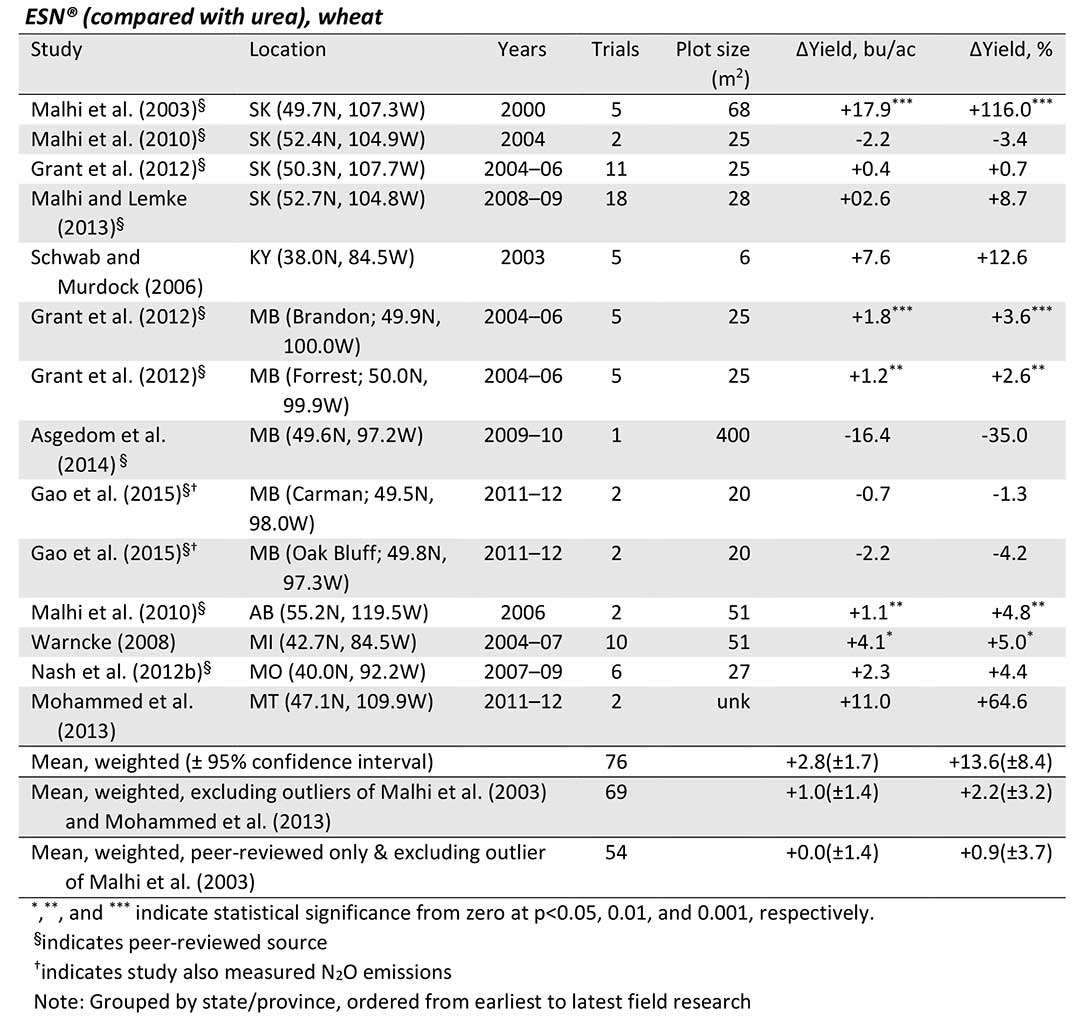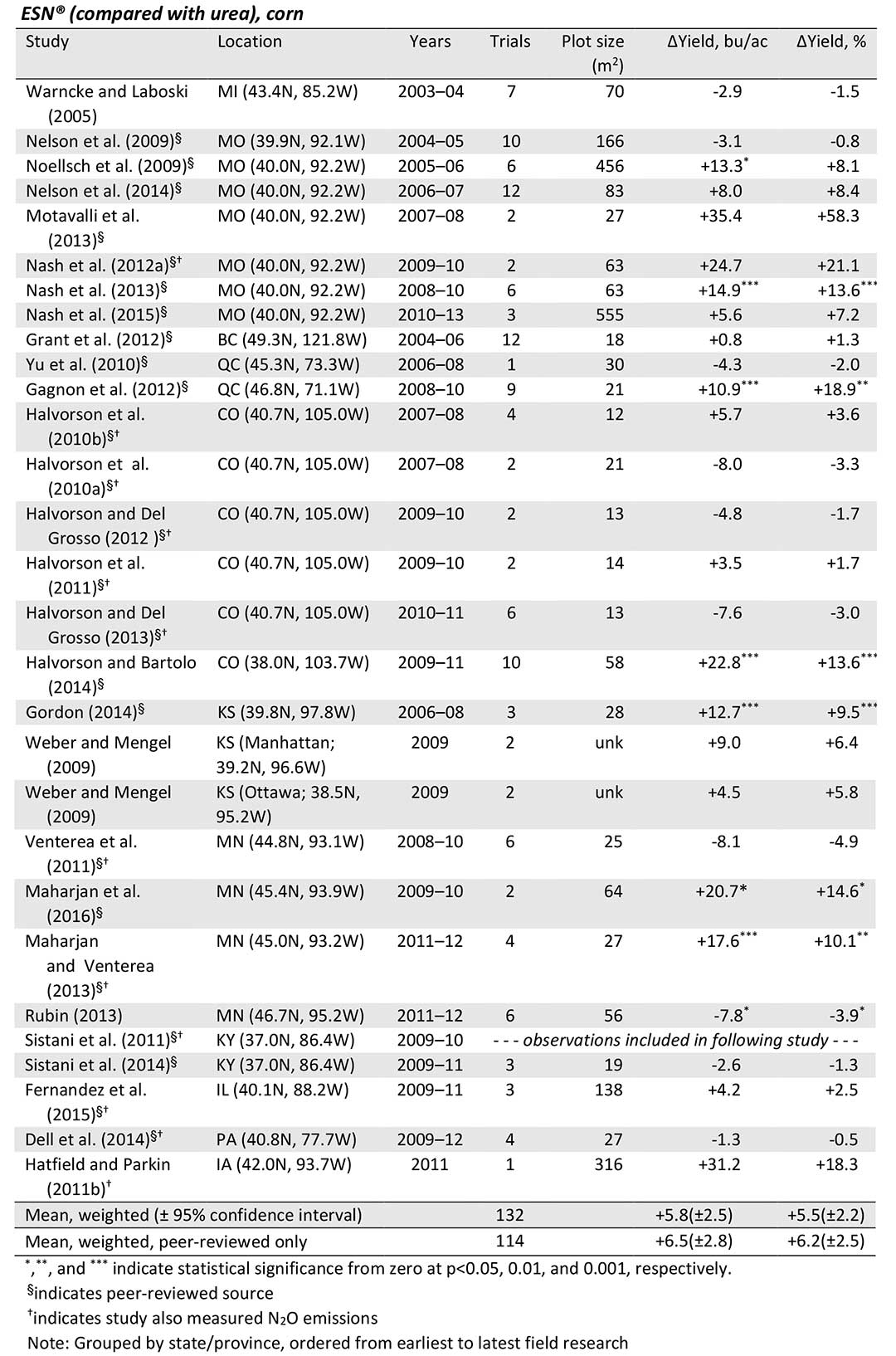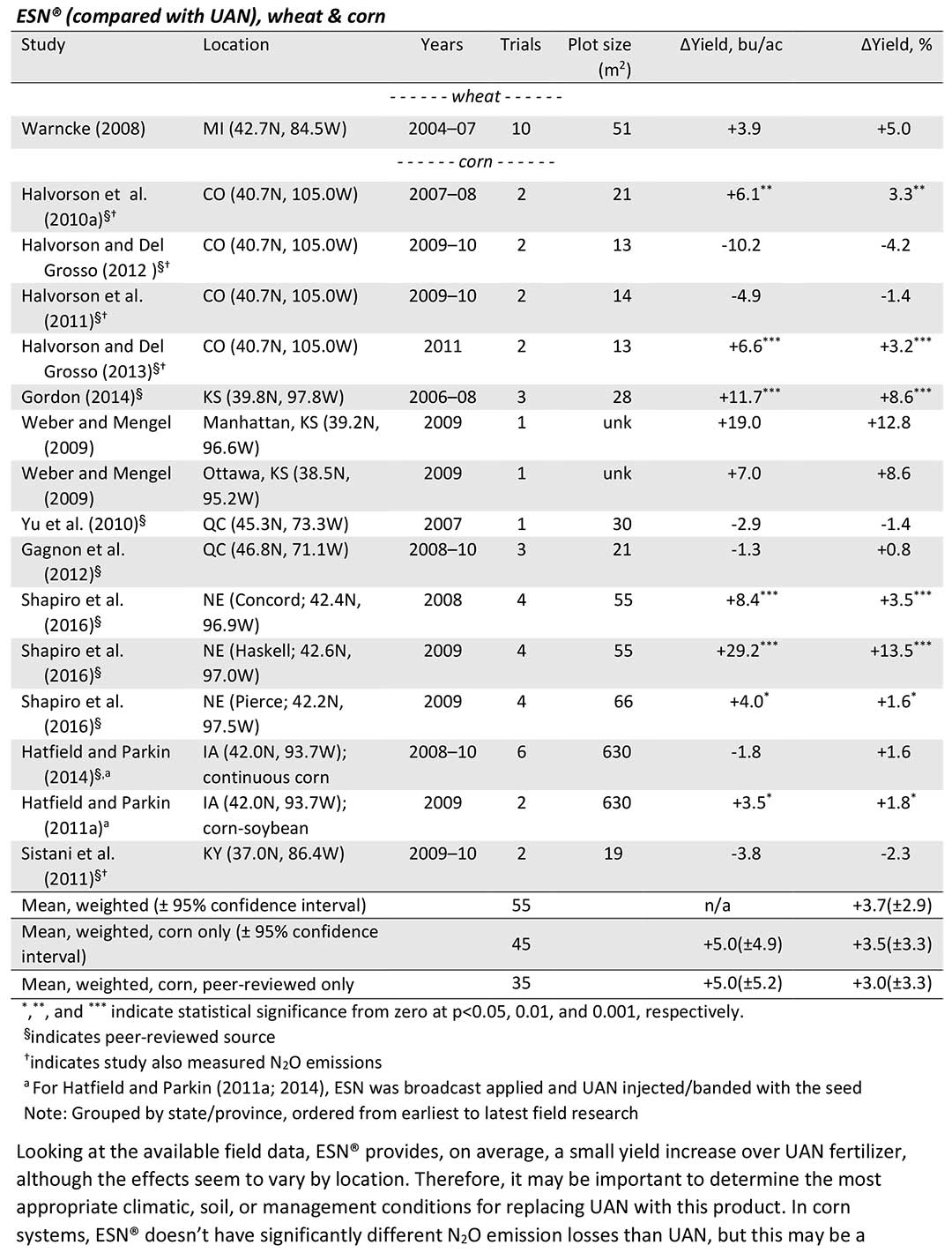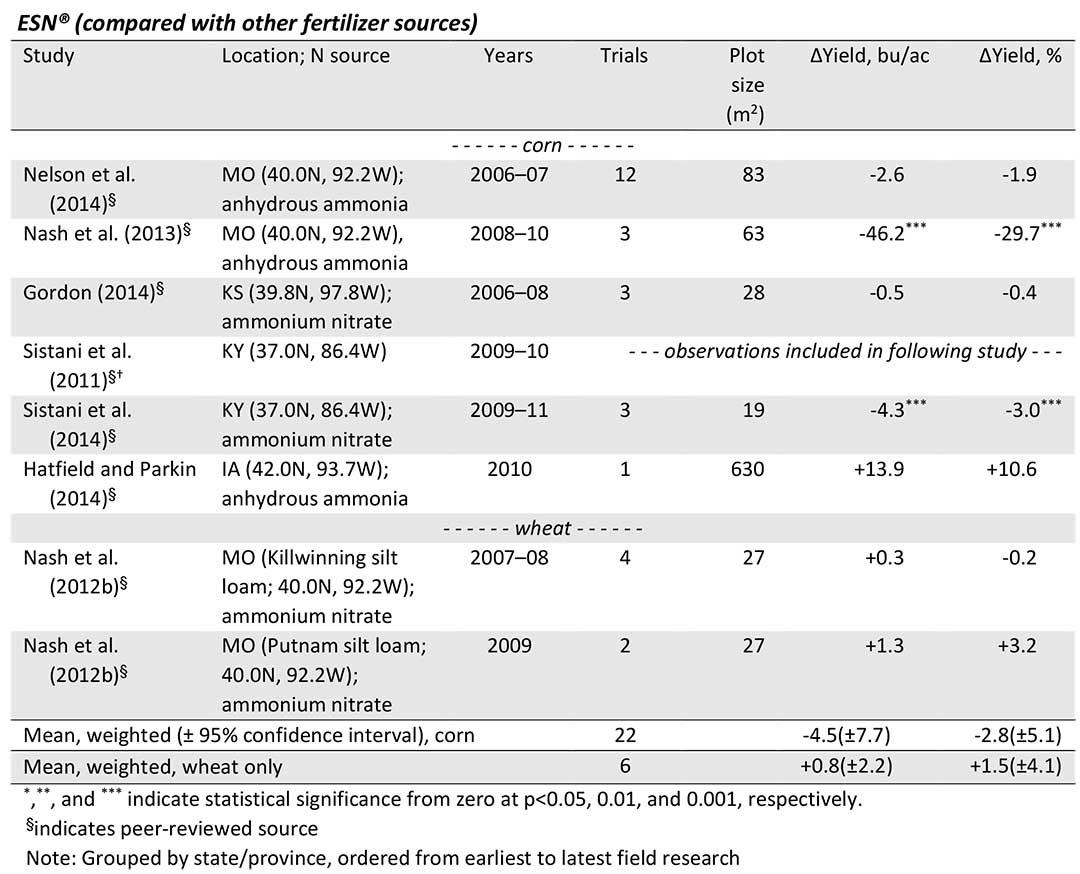ESN® Research Findings
The research findings reported here were obtained from a literature review performed by Alison Eagle of Duke University (Nicholas Institute for Environmental Policy Solutions) in May 2017 under contract to the Environmental Defense Fund.
Environmentally Smart Nitrogen (ESN®) is an enhanced efficiency nitrogen (N) fertilizer produced and distributed by Agrium.
It is a polymer-coated, controlled-release urea product (often referred to as PCU or CRU), designed to protect against environmental N losses through leaching, volatilization, and denitrification. The polymer membrane encapsulating the urea allows water to diffuse into the granule, creating a urea solution that slowly diffuses into the soil over a longer period of time, so it is promoted as an ideal pre-plant, single-application N fertilizer. The slow-release increases the amount of N available to the crop when it needs it, but reduces the amount of N exposed to loss mechanisms at any given time.
Based on these properties, ESN® is marketed to producers as a tool to increase N use efficiency (NUE) while decreasing the number of seasonal fertilizer applications needed, thus reducing supply and labor costs as well as soil compaction that results from multiple applications (Agrium Inc. 2014).
Though only distributed wholesale in the U.S. since 2014, ESN® has been on the retail market since 2004 and has been studied in North America since the 1990s, providing almost two decades of research on its efficacy as an enhanced efficiency fertilizer. Grain protein results from an early laboratory study with barley suggested that coated urea allowed for a slower fertilizer release, providing a higher N supply in later growth stages (Zhang et al. 2000). Coated urea applied alone had the greatest reduction in potential N loss compared to non-coated urea and a mixture of both. Early field trials conducted on spring wheat across many sites in western Canada from 1998–2000 found similar grain yield and higher grain N content from seed-placed ESN® compared to side-banded urea applied at equivalent rates (Haderlein et al. 2001). These trials also demonstrated an average nitrogen use efficiency increase with ESN® of 4.2% across all sites, with a maximum NUE increase of 35%.
Later field trials with spring wheat and canola found that ESN® also increased the safety of seed-placed urea as it reduced potential for both salt and free ammonia injury, providing a margin of safety equivalent to side-banded urea without all of the specialized equipment and a margin greater than that provided by Agrotain (Brandt et al. 2004). Similar plant survival results were also seen in winter wheat trials in Southern Alberta at high N application rates, and later studies at these locations demonstrated a slight grain yield increase with PCU (these were early versions of ESN®, according to the authors) compared to non-coated urea (McKenzie et al. 2010; McKenzie et al. 2007). Finally, a field lysimeter study from Ohio measured lower nitrate losses, with total N losses from spring-applied urea and UAN approximately 3 lbs N per acre (3.4 kg N per ha) greater than from spring-applied ESN® (Blaylock et al. 2004).
A search of the scientific literature and grey literature (conference proceedings etc.) was conducted to locate data on crop yield responses for ESN®. Data were incorporated into an existing database on fertilizer management field trials, including all available management, climate, soil, N loss, and crop productivity information.
The following tables summarize the yield impacts of ESN® with discussion below each table. Weighted averages are calculated where possible, with results from each study weighted by the inverse of the number of trials in each location. This prevents studies from very well-studied locations from overwhelming the average results.
Overall effect sizes are reported for all studies, and also restricted to peer-reviewed data and non-generic products, as applicable.

The positive overall weighted effect size for ESN® is strongly affected by very positive results from one study in Saskatchewan (Malhi et al. 2003) and another in Montana (Mohammed et al. 2013), for whom the significant grain yield impact was caused by poor seed emergence due to seed-row placement of the urea fertilizer (for the same reason, Malhi et al. 2003 also found AGROTAIN® to perform much better than urea). In these cases, the benefit from ESN® was not necessarily due to improved N use efficiency but to the coating of the fertilizer that reduced seedling damage and enhanced crop establishment. Excluding these outliers and the observations from the grey literature reveal a different overall average yield impact, one that is not statistically significant. Therefore, while ESN® replacing urea in wheat could certainly improve yield in a seed-row fertilizer placement scenario, generally improved NUE leading to greater wheat yield is not overwhelmingly supported with the data available.
In other related work, Malhi et al. (2011) compared ESN® with urea at two locations in Alberta, Canada, over a 27-year long crop study that included barley, wheat, canola, and field pea. They found that ESN® outperformed urea in terms of yield and N uptake at a site with lower soil carbon and greater N loss potential. However, urea generated greater straw yield and higher total N uptake at the other location. Thus, variability of ESN® performance by location seems worthy of further exploration, perhaps due to differences in soil C, texture, or climate.
Only one of the wheat field studies comparing ESN® and urea also measured N2O emissions, finding some reduction in emissions, depending on the year, and related to overall N availability (Gao et al. 2015). None of the wheat studies tested NO3 losses. Therefore, the main indicator of NUE effects is the yield response for this comparison. Some promise for improved NUE was found by Soon et al. (2011), who – while not reporting crop yield effect – measured higher N uptake and lower N2O losses from spring-applied ESN® versus urea in northern Alberta and Saskatchewan wheat cropping systems. In those field studies, there was little difference between sources that were fall applied, and the timing effect was much stronger than any impact of source.

For corn, ESN® has been compared with urea in many different locations in Canada and the United States. While individual experiments found both positive and negative yield impacts with ESN®, the overall weighted average yield gain was 5.5% (±2.2), or 6.2% (±2.5) when including only peer-reviewed studies. Thus, ESN® has potential to provide significant yield benefits for corn when applied with the same rate and timing as urea. In some cases there may also be opportunity for reducing overall N rates. Twelve of the studies that directly compared ESN® versus urea in corn also measured N2O emission losses (for a total of 38 comparisons), but there was no consistent impact.
In situations where it is difficult or inconvenient to side-dress N during the growing season, slow-release fertilizer like ESN® may be an alternative. However, two recent studies on corn in Minnesota noted better performance from split urea application when compared with single, pre-plant ESN® (Maharjan et al. 2014; Rubin et al. 2016). Maharjan et al. (2014) also measured lower NO3 losses with split urea compared to a pre-plant ESN® application. On the other hand, they did observe some N2O emission reductions with the ESN® treatment.

Looking at the available field data, ESN® provides, on average, a small yield increase over UAN fertilizer, although the effects seem to vary by location. Therefore, it may be important to determine the most appropriate climatic, soil, or management conditions for replacing UAN with this product. In corn systems, ESN® doesn’t have significantly different N2O emission losses than UAN, but this may be a result of the small sample size (10 observations in CO and KY, combined). In Iowa, Parkin and Hatfield (2014) measured N2O emissions for three different years, finding either no difference or increased N2O emissions from ESN® when compared to both urea and UAN (no yield reported, so emissions cannot be yield-scaled).

A small number of corn and wheat field studies also compare ESN® to other fertilizer sources, and these data show no difference in yield between sources.
Overall, considering all comparisons of ESN® with urea, UAN, and other sources, there is an average yield benefit of 3.7% (±1.8) from ESN® on corn and no significant benefit for wheat (+2.6% ±2.6). However, unrelated to nutrient use efficiency, ESN® protected seeds from fertilizer damage in some wheat studies, so that the average overall yield benefit for wheat was 11.5% (±6.8) when including these studies.
Based on the research data available from North America, ESN® provides yield benefits over commonly used N fertilizers when applied on corn at the same rate and timing. Improved yield in wheat experiments were mostly evident in situations where seed-placed fertilizer urea harmed seedling growth. Variability in the data suggests that there may be climate, soil, or cropping system conditions where ESN® is most effective compared to other sources. For example, Malhi et al. (2011) tested two sites, and observed better ESN® performance on the soil with lower organic C content and greater N loss potential. Regression models using the data provided in the studies examined above suggest that ESN is most effective in improving yield when fertilizer is applied prior to planting and may also be more effective in conventional tillage (compared to conservation or no-till). Other management factors as well as weather and soil are also likely to play a role. Because weather and soil data are inconsistently provided in these articles, gathering comparable climate and soil information from other sources (such as nearest weather stations) and using them for further assessment is likely to provide useful insight.
Agrium Inc. 2014. How ESN Works. [Online]. http://smartnitrogen.com/how-esn-works (verified 31 Jan 2016).
Asgedom, H., M. Tenuta, D.N. Flaten, X. Gao and E. Kebreab. 2014. Nitrous oxide emissions from a clay soil receiving granular urea formulations and dairy manure. Agronomy Journal 106(2):732–44. doi: 10.2134/agronj2013.0096.
Blaylock, A.D., R.D. Dowbenko, J. Kaufmann, G.S. Binford and R. Islam. 2004. ESN (R) controlled-release nitrogen for enhanced nitrogen efficiency and improved environmental safety. Abstracts of Papers of the American Chemical Society 228:U107.
Brandt, S., D. Steinley, B. Nybo, K. Stonehouse and S. Chalmers. 2004. Urea treatment affects safe rates of seed placed N. In Proceedings of the Proceedings of the Saskatchewan Soil Conservation Association Direct Seeding Conference. 11–12 Feb.
Dell, C.J., K. Han, R.B. Bryant and J.P. Schmidt. 2014. Nitrous oxide emissions with enhanced efficiency nitrogen fertilizers in a rainfed system. Agronomy Journal 106(2):723–31. doi: 10.2134/agronj2013.0108.
Fernandez, F.G., R.E. Terry and E.G. Coronel. 2015. Nitrous oxide emissions from anhydrous ammonia, urea, and polymer-coated urea in Illinois cornfields. Journal of Environmental Quality 44(2):415–22. doi: 10.2134/jeq2013.12.0496.
Gagnon, B., N. Ziadi and C. Grant. 2012. Urea fertilizer forms affect grain corn yield and nitrogen use efficiency. Canadian Journal of Soil Science 92(2):341–51. doi: 10.4141/cjss2011-074.
Gao, X., H. Asgedom, M. Tenuta and D.N. Flaten. 2015. Enhanced efficiency urea sources and placement effects on nitrous oxide emissions. Agronomy Journal 107(1):265–77. doi: 10.2134/agronj14.0213.
Gordon, W.B. 2014. Management of urea-containing fertilizers for no-tillage corn using nitrogen stabilizers and coated-granule technology. Journal of Plant Nutrition 37(1):87–94. doi: 10.1080/01904167.2013.848890.
Grant, C.A., R. Wu, F. Selles, K.N. Harker, G.W. Clayton, S. Bittman, B.J. Zebarth and N.Z. Lupwayi. 2012. Crop yield and nitrogen concentration with controlled release urea and split applications of nitrogen as compared to non-coated urea applied at seeding. Field Crops Research 127:170–80. doi: 10.1016/j.fcr.2011.11.002.
Haderlein, L., T.L. Jensen, R.E. Dowbenko and A.D. Blaylock. 2001. Controlled release urea as a nitrogen source for spring wheat in western Canada: Yield, grain N content, and N use efficiency. The Scientific World Journal 1:114–21.
Halvorson, A.D. and S.J. Del Grosso. 2012. Nitrogen source and placement effects on soil nitrous oxide emissions from no-till corn. Journal of Environmental Quality 41(5):1349–60. doi: 10.2134/jeq2012.0129.
Halvorson, A.D. and S.J. Del Grosso. 2013. Nitrogen placement and source effects on nitrous oxide emissions and yields of irrigated corn. Journal of Environmental Quality 42(2):312–22. doi: 10.2134/jeq2012.0315.
Halvorson, A.D. and M.E. Bartolo. 2014. Nitrogen source and rate effects on irrigated corn yields and nitrogen-use efficiency. Agronomy Journal 106(2):681–93. doi: 10.2134/agronj2013.0001.
Halvorson, A.D., S.J. Del Grosso and F. Alluvione. 2010a. Nitrogen source effects on nitrous oxide emissions from irrigated no-till corn. Journal of Environmental Quality 39(5):1554–62. doi: 10.2134/jeq2010.0041.
Halvorson, A.D., S.J. Del Grosso and F. Alluvione. 2010b. Tillage and inorganic nitrogen source effects on nitrous oxide emissions from irrigated cropping systems. Soil Science Society of America Journal 74(2):436–45. doi: 10.2136/sssaj2009.0072.
Halvorson, A.D., S.J. Del Grosso and C.P. Jantalia. 2011. Nitrogen source effects on soil nitrous oxide emissions from strip-till corn. Journal of Environmental Quality 40(6):1775–86. doi: 10.2134/jeq2011.0194.
Hatfield, J.L. and T.B. Parkin. 2011a. Nitrogen management: Unraveling the effects of timing and form. 41st North Central Extension-Industry Soil Fertility Conference 27:1–8.
Hatfield, J.L. and T.B. Parkin. 2011b. Evaluation of alternative forms of nitrogen fertilizer on agronomic performance and nitrous oxide emissions. National Laboratory for Agriculture and the Environment, Ames, IA. 4 pp.
Hatfield, J.L. and T.B. Parkin. 2014. Enhanced efficiency fertilizers: Effect on agronomic performance of corn in Iowa. Agronomy Journal 106(2):771–80. doi: 10.2134/agronj2013.0104.
Maharjan, B. and R.T. Venterea. 2013. Nitrite intensity explains N management effects on N2O emissions in maize. Soil Biology & Biochemistry 66:229–38. doi: 10.1016/j.soilbio.2013.07.015.
Maharjan, B., R.T. Venterea and C. Rosen. 2014. Fertilizer and irrigation management effects on nitrous oxide emissions and nitrate leaching. Agronomy Journal 106(2):703–14. doi: 10.2134/agronj2013.0179.
Maharjan, B., C.J. Rosen, J.A. Lamb and R.T. Venterea. 2016. Corn response to nitrogen management under fully-irrigated vs. water-stressed conditions. Agronomy Journal 108(5):2089–98. doi: 10.2134/agronj2016.01.0006.
Malhi, S.S. and R.L. Lemke. 2013. Effectiveness of seedrow-placed N with polymer-coated and NBPT-treated urea for canola and wheat. Journal of Plant Nutrition 36(14):2205–24. doi: 10.1080/01904167.2013.836227.
Malhi, S.S., E. Oliver, G. Mayerle, G. Kruger and K.S. Gill. 2003. Improving effectiveness of seedrow-placed urea with urease inhibitor and polymer coating for durum wheat and canola. Communications in Soil Science and Plant Analysis 34(11–12):1709–27. doi: 10.1081/css-120021307.
Malhi, S.S., Y.K. Soon, C.A. Grant, R. Lemke and N. Lupwayi. 2010. Influence of controlled-release urea on seed yield and N concentration, and N use efficiency of small grain crops grown on Dark Gray Luvisols. Canadian Journal of Soil Science 90(2):363-372.
Malhi, S.S., M. Nyborg, E.D. Solberg, M.F. Dyck and D. Puurveen. 2011. Improving crop yield and N uptake with long-term straw retention in two contrasting soil types. Field Crops Research 124(3):378–91. doi: 10.1016/j.fcr.2011.07.009.
McKenzie, R.H., A.B. Middleton, P.G. Pfiffner and E. Bremer. 2010. Evaluation of polymer-coated urea and urease inhibitor for winter wheat in southern Alberta. Agronomy Journal 102(4):1210–16. doi: 10.2134/agronj2009.0194.
McKenzie, R.H., E. Bremer, A.B. Middleton, P.G. Pfiffner and R.E. Dowbenko. 2007. Controlled-release urea for winter wheat in southern Alberta. Canadian Journal of Soil Science 87(1):85–91.
Mohammed, Y.A., T. Jensen, J. Heser and C. Chen. 2013. Inhibitors, method and time of nitrogen application for improved winter wheat production in central Montana. In Proceedings of the Western Nutrient Management Conference, Reno, NV.
Motavalli, P.P., K.A. Nelson and S. Bardhan. 2013. Development of a variable-source N fertilizer management strategy using enhanced-efficiency N fertilizers. Soil Science 178(12):693–703. doi: 10.1097/SS.0b013e31827dddc1.
Nash, P.R., P.P. Motavalli and K.A. Nelson. 2012a. Nitrous oxide emissions from claypan soils due to nitrogen fertilizer source and tillage/fertilizer placement practices. Soil Science Society of America Journal 76(3):983–93. doi: 10.2136/sssaj2011.0296.
Nash, P.R., K.A. Nelson and P.P. Motavalli. 2013. Corn yield response to polymer and non-coated urea placement and timings. International Journal of Plant Production 7(3):373–91.
Nash, P.R., K.A. Nelson, P.P. Motavalli and C.G. Meinhardt. 2012b. Effects of polymer-coated urea application ratios and dates on wheat and subsequent double-crop soybean. Agronomy Journal 104(4):1074–84. doi: 10.2134/agronj2011.0235.
Nash, P.R., K.A. Nelson, P.P. Motavalli and S.H. Anderson. 2015. Corn yield response to managed drainage and polymer-coated urea. Agronomy Journal 107(2):435–41. doi: 10.2134/agronj14.0273.
Nelson, K.A., S.M. Paniagua and P.P. Motavalli. 2009. Effect of polymer coated urea, irrigation, and drainage on nitrogen utilization and yield of corn in a claypan soil. Agronomy Journal 101(3):681–87. doi: 10.2134/agronj2008.0201.
Nelson, K.A., P.P. Motavalli and C.J. Dudenhoeffer. 2014. Cropping system affects polymer-coated urea release and corn yield response in claypan soils. Journal of Agronomy and Crop Science 200(1):54–65. doi: 10.1111/jac.12040.
Noellsch, A.J., P.P. Motavalli, K.A. Nelson and N.R. Kitchen. 2009. Corn response to conventional and slow-release nitrogen fertilizers across a claypan landscape. Agronomy Journal 101(3):607–14. doi: 10.2134/agronj2008.0067x.
Parkin, T.B. and J.L. Hatfield. 2014. Enhanced efficiency fertilizers: Effect on nitrous oxide emissions in Iowa. Agronomy Journal 106(2):694–702. doi: 10.2134/agronj2013.0219.
Rubin, J.C. 2013. Influence of Nitrogen Rate on Corn Grain Yield, Nitrogen Use Efficiency, and Nitrate Leaching on Coarse-Textured Minnesota Soils, University of Minnesota.
Rubin, J.C., A.M. Struffert, F.G. Fernandez and J.A. Lamb. 2016. Maize yield and nitrogen use efficiency in upper midwest irrigated sandy soils. Agronomy Journal 108(4):1681–91. doi: 10.2134/agronj2015.0552.
Schwab, G.J. and L.W. Murdock. 2006. Nitrogen fertilization for wheat grown on wet soils. In Proceedings of the 36th North Central Extension-Industry Soil Fertility Conference.
Shapiro, C., A. Attia, S. Ulloa and M. Mainz. 2016. Use of five nitrogen source and placement systems for improved nitrogen management of irrigated corn. Soil Science Society of America Journal 80(6):1663–74. doi: 10.2136/sssaj2015.10.0363.
Sistani, K.R., M. Jn-Baptiste and J.R. Simmons. 2014. Corn response to enhanced-efficiency nitrogen fertilizers and poultry litter. Agronomy Journal 106(2):761–70. doi: 10.2134/agronj2013.0087.
Sistani, K.R., M. Jn-Baptiste, N. Lovanh and K.L. Cook. 2011. Atmospheric emissions of nitrous oxide, methane, and carbon dioxide from different nitrogen fertilizers. Journal of Environmental Quality 40(6):1797–805. doi: 10.2134/jeq2011.0197.
Soon, Y.K., S.S. Malhi, R.L. Lemke, N.Z. Lupwayi and C.A. Grant. 2011. Effect of polymer-coated urea and tillage on the dynamics of available N and nitrous oxide emission from Gray Luvisols. Nutrient Cycling in Agroecosystems 90(2):267–79. doi: 10.1007/s10705-011-9428-2.
Venterea, R.T., B. Maharjan and M.S. Dolan. 2011. Fertilizer source and tillage effects on yield-scaled N2O emissions in a corn-cropping system. Journal of Environmental Quality 40(5):1521–31.
Warncke, D.D. 2008. Nitrogen Management for Soft Red Winter Wheat. In Proceedings of the 38th North Central Extension-Industry Soil Fertility Confernce.
Warncke, D.D. and C. Laboski. 2005. Evaluation of slow-release nitrogen materials in corn production. 35th North Central Extension-Industry Soil Fertility Conference Proceedings 21:1–10.
Weber, H.S. and D.B. Mengel. 2009. Use of nitrogen management products and practices to enhance yield and nitrogen use efficiency in no-till corn. 39th North Central Extension-Industry Soil Fertility Conference Proceedings 25:1–7.
Yu, H., N. Tremblay, Z. Wang, C. Belec, G. Yang and C. Grant. 2010. Evaluation of nitrogen sources and application methods for nitrogen-rich reference plot establishment in corn. Agronomy Journal 102(1):23–30. doi: 10.2134/agronj2009.0102.
Zhang, M.C., M. Nyborg, S.S. Malhi and E.D. Solberg. 2000. Yield and protein content of barley as affected by release rate of coated urea and rate of nitrogen application. Journal of Plant Nutrition 23(3):401–12. doi: 10.1080/01904160009382026.
